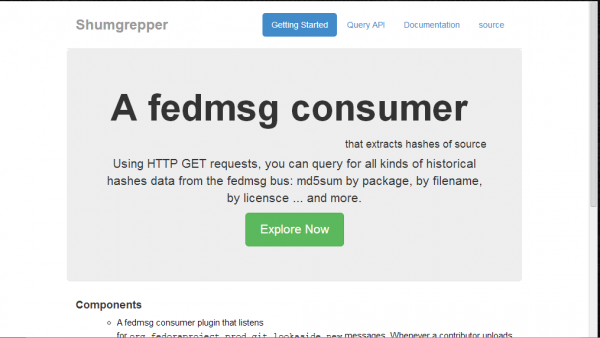No edit summary |
|||
| Line 269: | Line 269: | ||
| Pencils down period. Submitting the project for final evaluation. | | Pencils down period. Submitting the project for final evaluation. | ||
|} | |} | ||
[[category:Summer coding 2014]] | |||
Revision as of 19:20, 18 March 2014
Project Title : Shumgrepper
|
Contact Information |
|
|
About Me |
Fedora is my favorite Linux distro. I worked on a fedora project in past 3 months and I really enjoyed working on it. I also enjoy fedora community a lot. Till now, I have contributed to only one project. But I am looking forward to work more and in future i want to contribute to many other projects also.
Yes, I have contributed to Datagrepper project and Fedora-Packages.
I have 3 years experience of coding in Python language which is basic required skill of the project. Project Shumgrepper will integrate most of the features of project Datagrepper. I have already worked on Datagrepper project and have better understanding of the project. This project will involve developing the web-front end using python frameworks and I am already familiar with it. This makes me a strong candidate for this project. Did you participate with the past GSoC programs, if so which years, which organizations? No, I am applying for GSoC for the first time.
I have learnt a lot in these 3 months. If i get a chance, I would love to work more on other fedora projects.
In early May our summer vacation of college will start and ends by late of July; I can give my full time commitment to this project,. I assure dedication of at least 40 hours per week to the work and that I do not have any other obligations from early May till mid August. |
|
Past Experience |
|
I am Firefox Student Ambassador of my college and is involved in raising awareness about Open Source Software, FOSS organisation, Mozilla and its various products. I have always been involved in inspiring friends and juniors to contribute to open source projects. I have also given a talk in my institute to motivate people to apply for 'GSoc and OPW'. Besides this I have also organized many other coding events. Apart from this, I am always interested to get more and more women involved in free and open source software. |
|
OPW internship: Fedora-Datagrepper |
Link to pull requests: |
|
Goal |
|
Shumgrepper is a web app built on the top of Summershum. Summershum is a project that collects md5sum, sha1sum and sha521sum of every file present in every package. This can be used to check how many packages have the full GPL license, how many files contains a particular hash sum in all Fedora or to check the database in taskotron test, etc. It will bring up lot of new possibilities to developers, system administers and commiters by allowing them to verify the integrity and authenticity of a tarball, package or a individual source file. Not only this, it will help them in identifying changes made in packages and bundles by comparing check-sums. I will develop JSON/API along with Web front-end for the data generated by summershum. It will integrate most of the features of datagrepper along with user friendly real time visualization tool that will show ongoing changes in package hashes. The information related to package hashes is sensitive and can be vulnerable to various attack like DDos, So I will ensure security against it by taking appropriate security preventive measures. |
|
Project Details |
|
The project will mainly be divided into 5 phases.
|
|
Phase 1: Query building for Database |
|
In this phase of development I will add methods that will query summershum database to get required data.
-- One of the filtering arguments can be ‘filename’ which takes filename as value. http get https://apps.fedoraproject.org/shumgrepper?pkg_name=java-1.8.0-openjdk&filename=/jdk8/jdk/test/java/rmi/reliability/juicer/OrangeImpl.java The above query will return output in json form. Sample output will be: {"sha265sum":36828180b4cc683a13c2192fa0cf20aad0cdbc6ef194a40f6d20047b68a02c1c,"sha1sum":00014cdb3441f22fc1bcece2f94f29c29ab77fb2,
|
|
Phase 2: Web API Wrapper of the app |
|
The development in this part is involved with defining the web API wrapper which involves:
The implementation will be done using flask framework. Sample directory structure of the app: shumgrepper\
shumgrepper\
static\
css\
views.css
templates\
index.html
docs\
__init__.py
views.py
util.py
summershum.models\ # files containing methods that will query summershum
fedmsg.d\ # display fedmsg messages in human readable format
run.py
setup.py
Flask has a great similarity with MVC architecture as it contains view (templates), controller (views.py) and the model (summershum). views.py contains definition for various end-points. |
|
Phase 3: Web-Frontend |
|
In this part of development my aim is to build user-friendly web interface. For this, I will use mako template library to build the web-front end for end-points defined in the earlier phase. Apart from this I will also design and build the front page of the app. As discussed earlier the website is suspected to various attack. One of the prominent can be DDoS attack. In order to prevent it, it is important to distinguish between legitimate website visitors and automated or malicious clients. The above mentioned strategies can be implemented in the following steps:
I have made a demo front page:
|
|
Phase 4: Deployment |
|
In this phase i will deploy the package Shumgrepper in fedora production environment. This will enable users to install it via yum. It involves the following steps:
|
|
Phase 5: Integration |
|
It involves integrating the app on other applications and testing it
|
|
Deriverables |
|
|
Timeline | ||||||||||||||||||||||||||
|

